When you hear about remote mind control through electromagnetic waves, you might understandably dismiss it as science fiction or conspiracy theories.
The vast body of work—over 400 pieces of literature on brain manipulation—however, strongly points to its probable feasibility.
If you implant electrodes deep within the brain of humans and animals to deliver electrical stimulation, you can cause an extremely wide variety of emotional and behavioral changes depending on the sites stimulated.
Some of the confirmed responses are as follows:
Amygdala: rage, aggression, fear, flight, suicidal thoughts, pleasure, desire, romantic feelings, food intake, predation, water intake, mating, ovulation, uterine contractions (and childbirth/miscarriage), amnesia, discomfort, bodily functions (sneezing, vomiting, urination, etc.)
Hypothalamus: rage, aggression, fear, flight, panic attacks, suicidal thoughts, desire, food intake, predation, food refusal, water intake, erection, mating, ovulation, uterine contractions, adynamia (*), bodily functions (sneezing, vomiting, urination, etc.)
Periaqueductal gray: rage, aggression, fear, flight, panic attacks, desire, predation, mating, analgesia
Septal area: sexual pleasure, sexual desire, orgasm, food intake, erection, mating, inhibition of aggressiveness, analgesia
Medial forebrain bundle: desire, hypomania, food intake, ejaculation, mating
Ventral tegmental area: desire, food intake, water intake, mating
Nucleus accumbens: pleasure, desire, hypomania, food intake, laughter, fear, panic attacks, suicidal thoughts
Medial preoptic area: erection, mating, ovulation
Putamen: erection, mating, masturbation
Caudate nucleus: inhibition of aggressiveness, motor arrest, amnesia, sleep, adynamia (*), food refusal
Basal forebrain: sleep
Claustrum: disruption of consciousness
Anterior cingulate cortex: laughter, fear, motor arrest, discomfort
Hippocampus: fear, amnesia, discomfort
Insular cortex: pain, discomfort
Thalamus: pain, fear, sexual pleasure, sexual desire, orgasm, motor arrest, sleep
Pituitary gland: ovulation, uterine contractions
Brainstem: body manipulation, cardiac arrest, respiratory arrest, bodily functions (sneezing, vomiting, urination, etc.)
An inactive state accompanied by loss of muscle tone.
This could be abused, and in fact, in the 1970s, electrical brain stimulation was strongly condemned as a method for the government to mind control the population.
The fact that this was a serious debate is underscored by the U.S. Congress expressing concern in 1973 about the mass manipulation of the population using such technology, while the U.S. military provided financial support to prominent researchers in this field at that time.
For more information on these early allegations of mind control, see page 10.
If you can stimulate specific sites of the brain without electrodes, then you can manipulate human emotions and behavior at will from a distance, achieving “remote mind control.”
This is actually what the Defense Advanced Research Projects Agency (DARPA) of the Department of Defense has been trying to achieve through focusing microwave beams.
Just examining the scientific literature available to the public, you can see that modern technology has reached the point where it is possible to remotely stimulate specific sites of the brain using electromagnetic waves or ultrasonic waves, without the need for electrodes.
U.S. government agencies have long been interested in mind control and have conducted numerous studies investigating the effects of microwaves on behavior.
A senior scientific and policy adviser at the International Committee of the Red Cross indicated that such research is being carried out under the banner of developing non-lethal weapons, and warned that conspiracy theories about the government using microwaves for remote mind control are becoming a reality.
On page 1 of this article, I will describe various methods of remotely manipulating the nervous system.
From page 2 onwards, I will introduce numerous studies that show that direct electrical stimulation of the deep brain can induce emotions such as rage, fear, pleasure, desire, and inhibition, and can also freely manipulate the body, such as movements of limbs, cardiac arrest and respiratory arrest.
Efforts are also underway to turn animals into bio-robots, such as connecting their brains to the computer to manipulate the body or remotely control them like radio-controlled cars, and if such technology were to be abused against humans, the resulting catastrophe would be immense.
Chapters
Remote Neural Manipulation

The classical method of manipulating the nervous system is direct electrical stimulation via implanted electrodes.
However, sophisticated new methods allow for indirect manipulation of the nervous system without implants, using electromagnetic waves, electric currents, and ultrasonic waves.
I will primarily deal with electromagnetic waves, with reference to currents and ultrasonic waves.
Experiments have confirmed that even weak electromagnetic waves or electric currents, insufficient to directly fire neurons, can activate them through a process called "brain entrainment," by matching the frequency to the brain's physiological oscillations.
Furthermore, to induce clear behavioral changes, localized brain stimulation is essential.
Recently, a technique called "temporal interference (TI) stimulation" was developed, where two currents of slightly different frequencies are applied to the head, creating an extremely low-frequency composite wave at the intersection to activate specific deep brain sites through brain entrainment.
Utilizing beamforming technology, this has been expanded to the method using electromagnetic waves.
The critical issue is the development of non-lethal and directed energy weapons by many nations: some sources suggest some of these weapons are intended to interfere with human brain functions, thereby implying the existence of mind control weapons.
Table of ContentsAll_Pages
Electromagnetic Pulses (TMS)
By passing a brief current through a magnetic coil, an electromagnetic pulse (magnetic pulse) is generated, and the current generated by electromagnetic induction can activate neurons in specific regions of the brain.
This is called transcranial magnetic stimulation (TMS).
Coils come in many shapes, with circular coils being relatively powerful, and figure-eight coils being more focused and producing maximum power at the intersection of the two coils. (Hallett 2007)

TMS is thought to be able to reach a depth of about 1.2-2.0 in (3-4 cm) in the brain. (Terao and Ugawa 2002)
Therefore, TMS is usually limited to stimulation of neocortical areas on the brain surface.
TMS can cause both facilitation and suppression of brain activity. (Silvanto and Cattaneo 2017)
In general, low intensity produces facilitation, while high intensity produces suppression, but this depends on brain state and other factors.
The suppressive effects of TMS can suppress activities in specific brain regions, disrupting the brain functions specific to those regions.
For example, it is known that TMS electromagnetic pulses applied to the temporal lobe disrupt speech, to the occipital lobe disrupt vision, and to the frontal lobe disrupt short-term memory. (Devlin and Watkins 2006, de Graaf et al. 2014, Balconi 2013)
Also, the facilitative effects of TMS can activate specific sites of the motor cortex, contracting muscle groups in specific parts of the body. (Sondergaard et al. 2021)
Due to these effects, TMS is increasingly being used as a research tool to investigate brain functions.
TMS generates a single electromagnetic pulse, and when this pulse is generated periodically, it is called repetitive TMS.
Repetitive TMS covers the physiological oscillation range of the brain, from the delta-theta band (0.5-7 Hz) to the gamma band (approximately 100 Hz). (Thut et al. 2011)
This makes it possible to affect brain activity by externally interfering with brain oscillations, a phenomenon known as brain entrainment.
Brain Oscillations and Brain Entrainment
Brain Oscillations
Brain oscillations are observed at various levels in the brain, from localized ones obtained from implanted electrodes to global ones that appear as brainwaves.
Individual neurons fire irregularly with low frequency, but when they form networks, they exhibit oscillatory properties. (Brunel and Hakim 1999)
These oscillations are thought to synchronize neuronal populations distributed widely throughout the brain, serving to integrate various brain regions. (Knyazev 2007)
Classification of Brain Oscillations
The frequency bands of human brainwaves are divided into delta (0.5–3.5 Hz), theta (4–7 Hz), alpha (8–12 Hz), beta (13–30 Hz), and gamma (>30 Hz). (Engel and Fries 2010)
These frequency bands are believed to have certain functions and to be associated with specific processes. (Knyazev 2007)
Delta, theta, and alpha oscillations are global brainwaves that span relatively broad regions.
Beta and gamma oscillations are local brainwaves, distributed over more limited topographical regions.
Delta waves (0.5–3.5 Hz)
Delta waves are associated with desire. (Knyazev 2007)
They are generated in the brain stem, which is said to govern instincts.
In addition, delta waves are also generated in the ventral tegmental area, nucleus accumbens, and medial prefrontal cortex, which are important brain regions related to desire.
Delta waves tend to increase when basic needs must be met.
For example, delta waves amplify when you are hungry or sexually aroused.
When a human reached orgasm, delta waves of 1.5 to 2 Hz appeared in the septal area. (HEATH 1972)
Theta waves (4–7 Hz)
Theta waves are associated with emotions and memory. (Knyazev 2007)
They are generated in the limbic system, which is said to govern emotions and memory.
For example, when mice froze in fear, the hippocampus and amygdala oscillated in the theta band.
Also, when humans experienced fear, theta waves increased in the amygdala and medial frontal cortex. (Chen et al. 2021)
In patients with pathological aggression, an increase in theta band activity was observed in the hypothalamus. (Rosa et al. 2012)
Alpha waves (8–12 Hz)
Alpha waves are associated with inhibition. (Knyazev 2007)
They are generated in the cerebral cortex, which is said to govern reason.
An increase in alpha waves inhibits unnecessary distracting processes, allowing you to focus your attention on the task at hand.
Therefore, an increase in alpha waves correlates with improved cognitive performance.
Beta (13–30 Hz) and Gamma Waves (>30 Hz)
Beta waves are associated with sensations and movements, but their functions are poorly understood. (Engel and Fries 2010)
Gamma waves are known to accompany many cognitive functions, including perceptual processing, attention, arousal, object recognition, and language perception. (Herrmann et al. 2004)
Several studies have shown that during anger or aggressive behavior, limbic regions generate beta waves and gamma waves.
When patients were behaving emotionally, especially when they were angry, high-amplitude beta and gamma waves were consistently observed in the hippocampus at 12-20 Hz and in the amygdala at 18-35 Hz. (Heath 1964, Heath 1992)
In patients with pathological aggression, a decrease in alpha waves and an increase in beta waves were observed in the hypothalamus. (Rosa et al. 2012)
A study examining electrical activities in the medial prefrontal cortex, amygdala, and hypothalamus in mice showed that beta and gamma waves are engaged in aggressive behavior. (Yang et al. 2022)
Brain Entrainment
Brain oscillations can be driven by external force. (Thut et al. 2011)
If this force is periodic, natural brain oscillations will synchronize with the external oscillations. This is called brain entrainment.
There are two key points for inducing behavioral changes through brain entrainment using external oscillations.
- Target specific sites of the brain.
- Match the external oscillations to the functional frequencies of the target sites.
This will enable you to induce clear behavioral changes, such as those seen with direct electrical stimulation of the brain, using external oscillations like electromagnetic waves.
Recently developed temporal interference (TI) stimulation, which stimulates the brain with a localized composite wave created at the intersection of two waves, has made exactly this kind of stimulation possible.
On the other hand, it seems difficult to produce clear behavioral changes with external oscillations that are applied widely to the entire brain or that do not match the functional frequencies of the brain.
Extremely Low-Frequency Electromagnetic Waves
It has been observed that irradiation with extremely low-frequency electromagnetic waves, which match biological oscillation frequencies, causes neurons and brainwaves to entrain, producing behavioral changes.
This includes clear behavioral changes such as anger, fear, and hallucinations, which are seen with direct electrical stimulation of the brain.
Neuronal Entrainment
A Yale University study discovered that applying weak electromagnetic waves (alternating electric fields) of 2-4 V/m to the cerebral cortex in ferrets caused neurons to fire in sync with the frequencies of the electromagnetic waves. (Fröhlich and McCormick 2010)
Not only that, but they were able to speed up or slow down neuronal firing depending on the frequencies of the electromagnetic waves.

Neurons are firing spontaneously.

Neuronal firing is in sync with the electromagnetic waves.

Neuronal firing is in sync with the electromagnetic waves.

Neuronal firing is in sync with the electromagnetic waves.
When electromagnetic waves were close to the intrinsic frequency of the neurons (around 0.1 Hz), the neurons showed strong periodic fluctuations.
Brainwave Entrainment
When irradiated with electromagnetic waves, the brain has been confirmed to entrain to that frequency, amplifying brainwaves.
In a British study, repetitive TMS electromagnetic pulses were applied to the parietal lobe of the subjects at alpha frequency. (Thut et al. 2011)
They found that brainwaves in the alpha band, which is the same frequency as the applied frequency, were amplified.
In a German study, repetitive TMS electromagnetic pulses were applied to the occipital lobe of subjects at alpha frequency as well. (Zmeykina et al. 2020)
They found that brainwaves in the alpha band, which is the same frequency as the applied frequency, were amplified.
On the other hand, no such effect was observed when random electromagnetic pulses without periodicity were applied to the brain.
Japanese researchers hypothesized that different cortical regions have different intrinsic oscillation frequencies and tested this hypothesis through an experiment using repetitive TMS. (Okazaki et al. 2021)
Repetitive TMS electromagnetic pulses of theta (5 Hz), alpha (11 Hz), and beta (23 Hz) frequencies were applied to the visual cortex in the occipital lobe or the motor cortex in the parietal lobe of the subjects.
They found that in the motor cortex, beta-band brainwaves were amplified by beta-frequency electromagnetic waves, and in the visual cortex, alpha-band brainwaves were amplified by alpha-frequency electromagnetic waves.
Therefore, the results support the authors' hypothesis.
Behavioral Changes
Sleep
Spanish neurophysiologist Jose Delgado invented a halo-like device and helmet capable of delivering electromagnetic pulses to specific neural regions. (MCAULIFFE 1985, Horgan 2005)
The devices were tested on both animals and humans, successfully inducing drowsiness, arousal, and other states.
More pronounced effects were obtained when the electromagnetic pulses were adjusted to extremely low frequency, similar to that from power lines, i.e., gamma frequencies around 50–60 Hz.
The strength was very weak, several hundred times below that required to fire neurons using implanted electrodes, and roughly one-fiftieth (around 0.1 μT) of the Earth's magnetic field.
The induced effects were thought to be due to brain entrainment.
Indeed, when these weak electromagnetic pulses were applied to an isolated crab neuron, the neuron was found to change its firing rate to synchronize with the applied pulses.

Memory Loss
A Canadian research group investigated the effects of electromagnetic waves on cognitive ability when the temporal lobe was irradiated with them. (Persinger and Nolan 1985)
Within the temporal lobe, electromagnetic waves were thought to interfere particularly with the hippocampus and amygdala.
The subjects were asked to listen to a three-minute story and then retell it five minutes later.
While performing the task, the temporal lobe of the subjects was irradiated with electromagnetic waves in the theta band at 5 Hz. The irradiation time was either the first minute, the middle minute, or the last minute.
They found that the amount of story content that could be recalled decreased markedly, and the subjects took on an appearance of memory loss.
In particular, the subjects who were irradiated during the first minute had their recall content reduced to one-third.
Several animal experiments have confirmed that memory loss can be produced by electrical stimulation of the hippocampus and amygdala. (See page 6, "Inhibition.")
Therefore, you could say that electromagnetic waves were able to achieve the same effect as direct electrical stimulation of the brain.
Anger, Fear, Hallucinations
The research group went on to investigate responses induced by irradiation with electromagnetic waves to the temporal lobe. (Ruttan et al. 1990)
In the experiment, very weak electromagnetic waves of 0.03 to 0.1 μT were applied to the temporal lobe of the subjects for five minutes.
The frequencies of the electromagnetic waves were either theta waves (4 Hz), alpha waves (9 Hz), or beta waves (16 Hz).
This was designed to approximate the brainwaves generated by the amygdala and hippocampus.
They found that emotions such as anger, fear, and sadness were induced in the subjects, mainly with electromagnetic waves in the theta and alpha bands.
In addition, abnormal experiences were also induced, such as vestibular sensations (vibrations and floating sensations), immobility, depersonalization, and visual hallucinations.
It is well known that emotions such as anger and fear, as well as hallucinations, can occur by electrical stimulation of the amygdala and hippocampus. (See page 2, "Rage," and page 3, "Fear.")
Therefore, you could say that electromagnetic waves were able to achieve the same effects as direct electrical stimulation of the brain.
Below are some examples of subjects' statements regarding abnormal experiences:
- Spinning objects: “I see something mechanical turning round and round … and there is something brushing against it.”
- Depersonalization: “This is not real … I keep slipping into things”; “I feel there is something in here with me.”
- General vestibular effects: “I am flying in the air”; “It feels like vibrations are going through my chest.”
- Visual flying imagery: “Bats are flying in the air”; “I see a bird flying.”
- Proprioception and muscle spasms: “... tingling over my entire body”; “My eyes are jerking from side to side”; “I felt a weird ripple go through my head.”
- Immobilization: “I feel like I can’t move.”
- Wave motions: “It sounds like waves.”
- Dissociated thoughts: “I feel like I am in a story and I just woke up with a bug; he died.”
- Colors: blue-purple, yellowish-green and red-orange, in that order
- Phosphenes: “I see sparkles in a cave.”
Visual Suppression
Visual information captured by the retina is first transmitted to the primary visual cortex in the occipital lobe, but at this point the left and right information is inverted.
That is, information from the right visual field is projected onto the left side of the occipital lobe, and information from the left visual field is projected onto the right side of the occipital lobe.
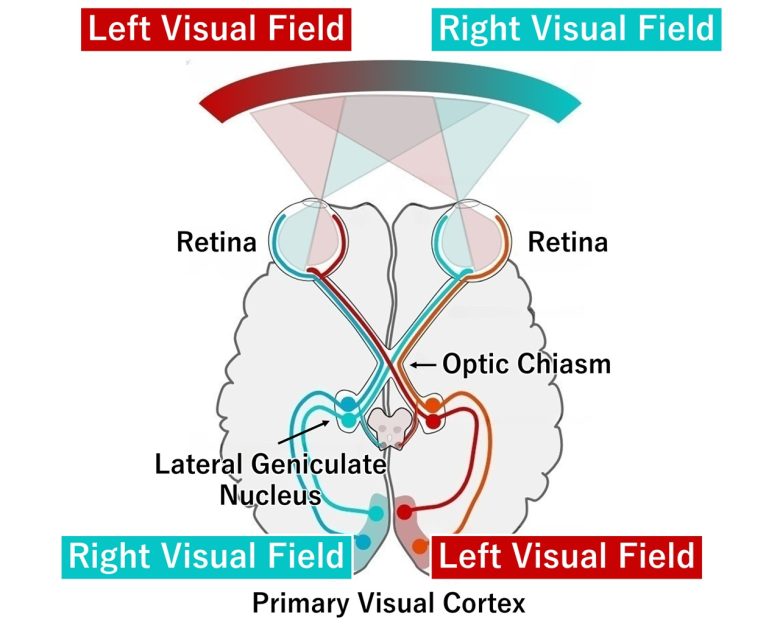
"Human visual pathway" by Miquel Perello Nieto is licensed under CC BY 4.0.
Irradiating the occipital lobe with electromagnetic waves has been shown to disrupt vision.
Researchers at the University of Hamburg in Germany investigated the effects of electromagnetic waves on vision when the occipital lobe was irradiated with them. (Sauseng et al. 2009)
The subjects were shown multiple squares for only 0.1 seconds and were instructed to remember only the squares in either the left or right visual field and ignore the other one.
After 0.9 seconds, the squares were shown again for 2 seconds and the subjects were asked to answer whether the color of the squares had changed.

While performing the task, repetitive TMS electromagnetic pulses at either 10 Hz alpha frequency or 15 Hz beta frequency were applied to either the left or right occipital lobe of the subjects.
They found that electromagnetic irradiation at alpha frequency caused the performance to go up or down depending on the sites irradiated.
When the occipital lobe on the opposite side was irradiated with electromagnetic waves, where the visual field that needs remembering is projected, the performance deteriorated. This can be said to be a result of the electromagnetic waves suppressing the necessary visual field.
When the occipital lobe on the same side was irradiated with electromagnetic waves, where the visual field that needs ignoring is projected, the performance improved. This can be said to be a result of the electromagnetic waves suppressing the unnecessary visual field.
On the other hand, no effect was seen with the irradiation with electromagnetic waves at beta frequency.
Therefore, the inhibitory role of alpha frequency has been demonstrated.
Increase/Decrease in Visual Memory
Visual memory decreased when the opposite side of the occipital lobe was irradiated with alpha frequency electromagnetic waves. On the other hand, visual memory increased when the same side of the occipital lobe was irradiated.
Researchers at the University of Glasgow in the UK also investigated the effects of electromagnetic waves on vision when the occipital lobe was irradiated with them. (Romei et al. 2010)
The subjects were instructed to press a button in response to a dot that appeared for just a moment in either the left or right visual field.
While performing the task, repetitive TMS electromagnetic pulses at either 5 Hz theta frequency, 10 Hz alpha frequency, or 20 Hz beta frequency were applied to either the left or right occipital lobe of the subjects.
They found that the alpha frequency electromagnetic waves showed an inhibitory effect on vision compared to the theta and beta frequencies.
When electromagnetic waves were applied to the occipital lobe on the opposite side, where the dot-appearing visual field was projected, the hit rate decreased. This can be said to be a result of the electromagnetic waves suppressing the necessary visual field.
When electromagnetic waves were applied to the occipital lobe on the same side, where the dot-not-appearing visual field was projected, the hit rate increased. This can be said to be a result of the electromagnetic waves suppressing the unnecessary visual field.
Increase/Decrease in Visibility
Visibility decreased when the opposite side of the occipital lobe was irradiated with alpha frequency electromagnetic waves. On the other hand, visibility increased when the same side of the occipital lobe was irradiated.
Decrease in Reaction Time
A study at the SUNY Upstate Medical Center discovered that electromagnetic radiation slows down human reaction time. (FRIEDMAN et al. 1967)
The subjects were asked to press a button in response to a flash of light.
While performing the task, 0.1 Hz or 0.2 Hz electromagnetic waves were applied to the entire heads of the subjects.
They found that the subjects exposed to the 0.2 Hz electromagnetic waves responded significantly slower to flashes of light.
On the other hand, 0.1 Hz had almost no effect.
This effect was more pronounced in the male subjects.
Decrease in Reaction Time
Radio-Frequency Electromagnetic Waves (Microwaves)
It has been confirmed that irradiation with microwaves, a type of radio-frequency electromagnetic waves, can also produce changes in neurons, brainwaves, and behavior.
The key to producing these changes appears to be modulating the microwaves at extremely low frequency in the brainwave band.
Unmodulated continuous microwaves often suppress neuronal activity or have no effect at all.
Neuronal Activation
Pulse-Modulated Microwaves
Neurons have been shown to activate when irradiated with microwaves pulse-modulated at extremely low frequency.
A researcher at Pennsylvania State University discovered that irradiating the heads of cats with pulse-modulated microwaves produced electrical signals near the brain stem. (Frey 1967)
The irradiation was performed on the dying cats whose brainwaves were hardly detectable.
The microwaves were 12-15 GHz and pulse-modulated in the brainwave band of 12-130 Hz.
The intensity was 30 μw/cm2, which was four orders of magnitude lower than the value required to cause an increase in body temperature.
The induced electrical signals varied depending on the brain sites. In the subthalamic nucleus, the response was rapid and brief, while in the reticular formation, the response was slower, more diffuse, and prolonged.
No significant differences were observed depending on the modulation frequencies.


Russian researchers showed that pulse-modulated microwaves activated snail neurons. (Bolshakov and Alekseev 1992)
The microwaves had a frequency of 900 MHz, an intensity with an SAR of 0.5–4 W/kg, and were either pulse-modulated at extremely low frequency between 0.5 and 110 Hz or continuous waves without modulation.
When the neurons were irradiated with pulse-modulated microwaves, the firing rate increased sharply and bursts appeared.
On the other hand, no change was observed with continuous microwaves.
Researchers at SUNY Geneseo showed that irradiating the heads of zebra finches with pulse-modulated microwaves activated neurons in the brains. (Beason and Semm 2002)
The microwaves had a frequency of 900 MHz, an intensity of 100 μW/cm2, and were pulse-modulated at 217 Hz. This was designed to mimic the microwaves emitted by second-generation mobile phones.
Neuronal activity was recorded from the electrodes inserted in the parietal lobe, occipital lobe, and anterior part of the cerebellum.
They found that more than half of the neurons tested showed changes in activity.
In most of the neurons that responded, an average increase of 3.5 times in firing rate was observed, but in some neurons, a decrease in firing rate was noted.
When the microwaves were not modulated at extremely low frequency, neither facilitation nor suppression of neuronal activity was observed.

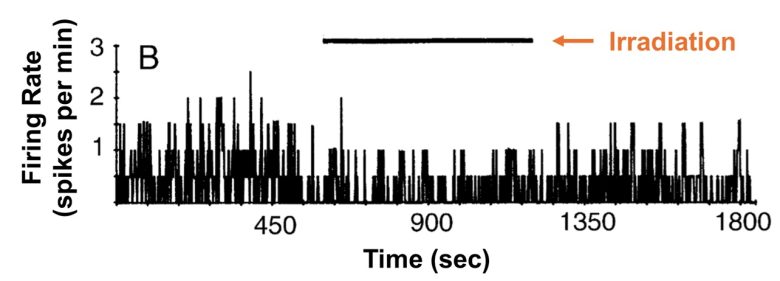
Continuous Microwaves
It has been shown that irradiating the nervous system with unmodulated, continuous microwaves primarily suppresses neuronal activity in the brain.
Researchers at Temple University irradiated the hind limbs of mice with continuous 60 GHz millimeter waves to investigate the effects on the peroneal nerve. (Alekseev et al. 2009)
They found that the activity of the peroneal nerve was suppressed during irradiation with millimeter waves, and activity temporarily increased after irradiation ended.
The intensity of the millimeter waves was quite strong at 160 mW/cm2, and was accompanied by a temperature change of several degrees.

At the Huntington Medical Research Institutes, slices of rat cerebral cortex were irradiated with continuous 60 GHz millimeter waves for one minute. (Pikov et al. 2010)
They found that of the eight neurons examined, the activity of four with low firing rates was suppressed by irradiation with the millimeter waves, while the activity of four with high firing rates was conversely facilitated.
The intensity of the millimeter waves was less than 1 μW/cm², which is less than one-thousandth of the safety standard.
Facilitation and Suppression of Neuronal Activity
The activity of the four neurons with low firing rates was suppressed by irradiation with the millimeter waves, while the activity of the four neurons with high firing rates was conversely facilitated.
Brainwave Entrainment
Irradiating the head with microwaves pulse-modulated at extremely low frequency has been shown to cause the brain to entrain to the modulated frequency, amplifying brainwaves.
Hungarian researchers investigated the effect of microwaves on the brainwaves of rats. (Thuröczy et al. 1994)
In the experiment, the heads of rats were irradiated with microwaves with a frequency of 2.45 GHz and an intensity of 8.4 W/kg, either as continuous waves or amplitude-modulated at the beta band of 16 Hz.
They found that microwaves amplitude-modulated at the beta band amplified brainwaves in the beta band (14.5-30 Hz).
On the other hand, continuous microwaves had no effect on brainwaves.
Estonian researchers investigated the effects of microwaves on human brainwaves. (Hinrikus et al. 2008)
The left temporal region of the subjects was irradiated with microwaves with a frequency of 450 MHz and an intensity of 160 μW/cm2.
The microwaves were pulse-modulated at 7, 14, 21, 40, 70, 217, and 1000 Hz, and changes in brainwaves in three bands, theta, alpha, and beta, were investigated.
7 Hz modulation of theta waves showed a more pronounced amplification of theta waves than other modulations, and an amplification of alpha waves was also observed.
14 Hz and 21 Hz modulation of beta waves showed a large amplification of the alpha band as well as an amplification of the beta band.
At higher modulation frequencies, alpha waves and beta waves were amplified to the same extent, and no significant changes were observed at 1000 Hz.
As a general trend, alpha waves were commonly amplified, and the band close to the modulation frequency was amplified.
Behavioral Changes
Convulsive Death
The National Institute of Neurological Disorders and Blindness (now the National Institute of Neurological Disorders and Stroke) discovered that irradiating the brain stem with microwaves produced convulsions and eventual death in rhesus monkeys. (Bach et al. 1959, Aviation Week 1959)
The microwaves had frequencies between 380 and 395 MHz and a high intensity of 64 mW/cm², and were mainly continuous waves, sometimes amplitude-modulated at 500 or 1000 Hz.
The radio antenna was aimed at the heads of the rhesus monkeys so that it was in line with the brain stem, the central vital portion of the brain.
According to Director Dr. Bailey, the monkey became drowsy within a few seconds of irradiation. After about a minute, they became agitated and began to move their heads from side to side.
In another minute there appeared "unmistakable signs of some impending disturbance in the vital centers of the brain, which were probably resonating with these electromagnetic waves."
The monkey then went into a major convulsion and died a few seconds later.
Ten monkeys died as a result of the exposure, and another ten monkeys, whose exposure was cut short of death, showed symptoms similar to Parkinson's disease in humans.
Two monkeys fell into quadriplegia, two exhibited weakness in the upper limbs, and several showed ataxia for varying periods.
When they dissected the monkeys' brains, tissue damage was found in the brain stem and cerebellum.
Dr. Bailey acknowledged the possibility of brain damage caused by microwaves and speculated that this might explain the "mysterious airplane accidents."
Other symptoms also occurred, including ptosis, dilated pupils, nystagmus, flushing, salivation, and lacrimation.
In one monkey, turning the transmitter on and off alternately made it aroused and relaxed over a 20-second cycle, and the monkey reacted like a puppet on the end of a string.
The above symptoms were considered to be similar to those produced by direct electrical stimulation of the brain stem.
It has actually been confirmed that direct electrical stimulation of the brain stem can cause cardiac arrest, respiratory arrest, and various other bodily functions. (See page 7, "Movements.")
However, since tissue damage was confirmed in this experiment, I think that the principle is different from that of electrical stimulation using conventional implanted electrodes, which does not cause damage from the stimulation itself.
Cardiac Arrest
Researchers at Pennsylvania State University showed that microwaves could stop the heart of a frog. (Frey and Seifert 1968)
The experiment began by decapitating the frogs and removing the hearts.
The isolated heart beat at a slowly decreasing rate of approximately one beat per second, and this rate remained stable for at least 20 minutes.
The stably beating hearts were then irradiated for 10 seconds with 1.425 GHz pulse-modulated microwaves. The intensity was very weak, 0.6 μW/cm2, and even mobile phones emit electromagnetic waves of this magnitude.
The microwave pulses were designed to be in sync with the heartbeats and were delivered 200 milliseconds after the peak of the P wave.
They found that the heart rate increased, and in half of the cases, arrhythmias occurred.
And surprisingly, the hearts sometimes stopped after the arrhythmias.
It has been observed that when electrical stimulation in sync with the heartbeat was applied to the insular cortex of the brains of living rats, the heart rate similarly increased, arrhythmias occurred, and eventually the rats suffered cardiac arrest and died. (See page 7, "Movements.")
This means that irradiating the heart or brain with pulse-modulated microwaves in sync with the heartbeat could kill humans and animals.
This shows the potential for microwaves to be used as a highly covert lethal weapon, and in fact this research was funded by the U.S. Naval Research Laboratory.
Decrease in Memory
Mobile phones emit pulse-modulated microwaves, which contain extremely low-frequency components in the brainwave band.
For example, in second-generation mobile phones, extremely low-frequency components of the theta band at 5.6, 5.86, 6.8, and 8 Hz have been detected most strongly. (Misek et al. 2023)
Finnish researchers showed that exposure of the temporal lobe to electromagnetic waves from second-generation mobile phones markedly reduced working memory. (Krause et al. 2003)
The subjects were presented with four verbs audibly and asked to determine whether the verb presented two seconds later had already been presented.
The mobile phones were fitted to the left sides of their heads, and the error rates were compared between the groups that had their mobile phones on and off during the test.
They found that the error rate in the off group was 6.3%, while that in the on group was 19.1%, more than three times higher.
Several animal studies have confirmed that memory loss can be induced by electrical stimulation of the hippocampus and amygdala in the temporal lobe. (See page 6, "Inhibition.")
Therefore, you could say that electromagnetic waves were able to achieve the effect similar to direct electrical stimulation of the brain.
Sleep Disruption and Promotion
British researchers showed that exposure to electromagnetic waves from second-generation mobile phones disrupted sleep onset. (Hung et al. 2007)
The subjects were fitted with mobile phones on the right sides of their heads and exposed to electromagnetic waves in either "talk," "listen," or "standby" mode while sleeping.
They found that exposure to talk-mode electromagnetic waves more than doubled the time it took to fall asleep, from 24 minutes to 49 minutes.
In addition, a decrease in the power of 1-4 Hz delta waves was also observed in the frontal part of the heads.
On the other hand, Swiss researchers showed that electromagnetic waves similar to those from mobile phones promote sleep onset. (Borbély et al. 1999)
In the experiment, the subjects were exposed to 900 MHz microwaves mimicking the electromagnetic waves from second-generation mobile phones on the left sides of their heads to investigate the effects on sleep.
The microwaves were pulse-modulated to include frequency components of 2, 8, 217, and 1736 Hz, like second-generation mobile phones.
They found that the time it took to fall asleep was reduced from 18 minutes to 12 minutes.
In addition, an increase in alpha brainwaves at 10 Hz and 13.5 Hz was also observed during the early stages of sleep.
TI Stimulation (Current Stimulation)
Brain activity can be influenced by passing an electric current to the brain through the electrodes placed on the head.
A recently developed method called temporal interference (TI) stimulation has made it possible to selectively stimulate specific sites deep within the brain by crossing two electric currents.
Electric Current Stimulation (TES)
Transcranial electrical stimulation (TES) is a technique that modulates neuronal activity by passing a weak electric current through the skull into the brain.
TES involves passing a low-intensity electric current of about 1-2 mA between the two electrodes placed on the scalp.

TES is said to enhance cognitive abilities in healthy individuals and is also used to treat conditions such as depression. (Fertonani and Miniussi 2016)
A variety of current waveforms can be used for stimulation, with the three main types being direct current stimulation, alternating current stimulation, and random noise stimulation.

The three forms of TES
(Modified from Saiote et al. 2013)
These forms of currents change the membrane potential of neurons: not enough to trigger an action potential, but enough to produce a change in firing rate.
TI Stimulation
Stimulation of Specific Sites Deep within the Brain
A research group at the Massachusetts Institute of Technology developed a new method of TES called temporal interference (TI) stimulation. (Grossman et al. 2017)
This involves applying electric currents with slightly different frequencies from separate electrodes, activating neurons with a composite wave formed at the intersection of the two currents.
In the experiment, two electrodes were placed on the scalp of mice, and currents of 2000 Hz and 2010 Hz were applied to target the hippocampus.
This would generate a composite wave with an envelope of a difference frequency of 10 Hz.
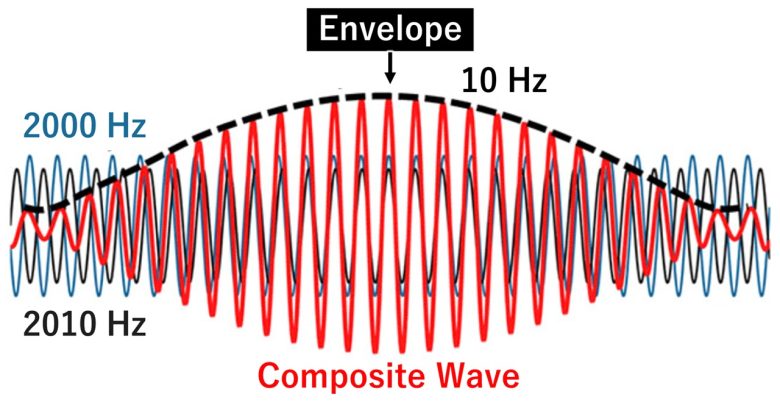
As a result, they were able to activate only the hippocampus, located deep within the brain, without activating the neocortical area on the surface.
The neurons did not follow the high-frequency oscillations of 2000 Hz and 2010 Hz, but they did follow the low-frequency oscillation with a difference frequency of 10 Hz.
This made it possible to apply electrical stimulation limited to specific sites deep within the brain without implanting electrodes.
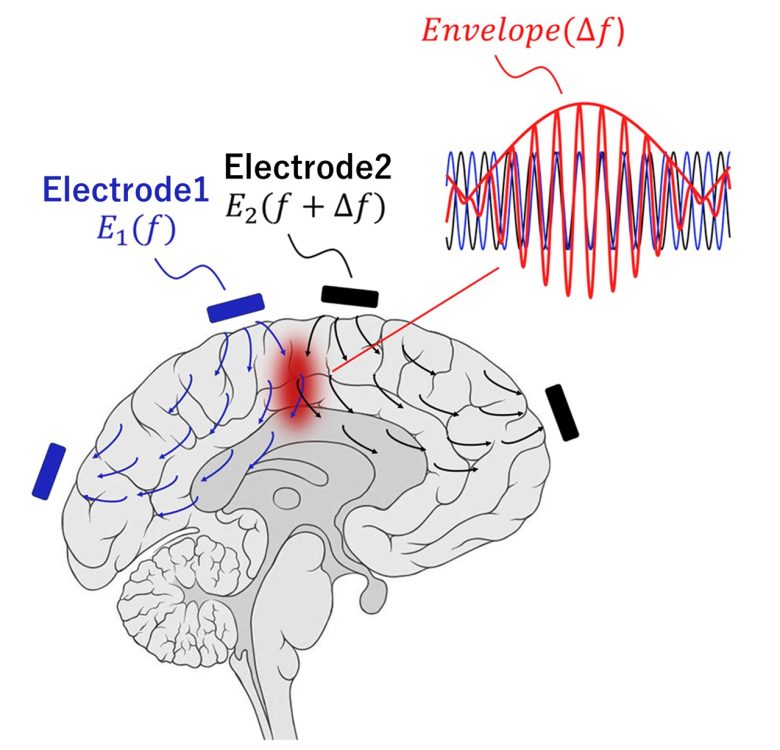
Neuronal Entrainment
Furthermore, the experiment also showed that neurons fired in sync with the difference frequencies between the two currents.
Targeting the forelimb region of the motor cortex, a current of 2000 Hz and another currents of 2001, 2005, or 2010 Hz were applied to the heads of mice.
They found that the forelimbs of the mice moved in sync with the difference frequencies of 1 Hz, 5 Hz, and 10 Hz.
French researchers likewise showed that neurons fired in sync with the differential frequency of two currents during TI stimulation. (Botzanowski et al. 2022)
In the experiment, they applied TI stimulation targeting the sciatic nerve of mice, with a carrier frequency of 3000 Hz and difference frequencies of 0.5–5 Hz in delta frequency.
They found that the hindlimbs of mice moved in sync with the differene frequencies.
TI stimulation has inspired many researchers to conduct studies targeting various brain regions.
Improvement in Memory and Emotional Changes
British researchers showed that TI stimulation to the human hippocampus activated the stimulated site and somewhat improved memory. (Violante et al. 2023)

The subjects were presented with 16 sets of illustrations of faces and names, each for 2 seconds, and were later asked to recall the names from the faces.
While performing the task, TI stimulation was applied targeting the hippocampus of the subjects, with a carrier frequency of 2000 Hz and a difference frequency of 5 Hz in theta frequency.
The 5 Hz frequency is based on the fact that the hippocampus oscillates in the theta band during episodic memory.
They found that the stimulation activated the hippocampus, resulting in a slight improvement in the subjects' memory.
However, as a side effect, emotional changes such as anxiety, nausea, and discomfort occurred, which were not observed in the sham stimulation group.
Electrical stimulation of the hippocampus has been shown to produce fear responses. (See page 3, "Fear.")
Therefore, you could say that TI stimulation was able to achieve the effects similar to those of direct electrical stimulation of the brain.
Improvement in Motor Learning
German researchers showed that TI stimulation to the human striatum activated the stimulated site and improved motor learning. (Wessel et al. 2023)
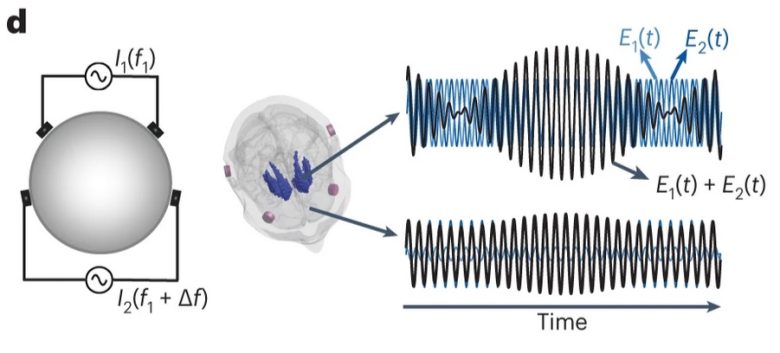
The subjects were asked to replicate a sequence of numbers displayed on the screen as quickly and accurately as possible, using the five fingers (corresponding to the numbers) of their non-dominant hands.
While performing the task, TI stimulation was applied targeting the striatum of the subjects, with a carrier frequency of 2000 Hz and a difference frequency of 5 Hz in theta frequency.
Theta waves are known to appear in the hippocampus, cerebral cortex, and basal ganglia during learning, and to facilitate neuronal synapse formation.
They found that activity in the striatum and associated motor networks increased.
Furthermore, motor learning performance improved in the elderly subjects, whose motor learning ability is declined.
However, no such effect was observed in the young subjects.
Improvement in Motor Learning
Eye Movements
Chinese researchers applied TI stimulation targeting the superior colliculus located deep within the brain of mice, with a carrier frequency of 2000 Hz and difference frequencies of 1–5 Hz. (Song et al. 2021)
They found that saccadic eye movements were induced in the mice.
Furthermore, the eyes moved in sync with the difference frequencies of 1 Hz, 2 Hz, and 5 Hz.
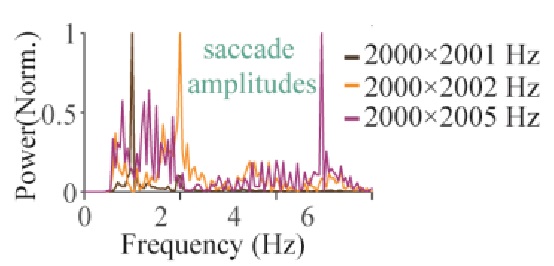
Epileptic Seizures
French researchers applied TI stimulation targeting the hippocampus of rats, with a carrier frequency of 1200 Hz and a difference frequency of 50 Hz at gamma frequency. (Missey et al. 2021)
They found that all of the mice experienced epileptic seizures.
The behavior of the seizures induced by TI stimulation was identical to that induced by conventional electrical stimulation of the hippocampus.
Therefore, you could say that TI stimulation was able to achieve the same effect as direct electrical stimulation of the brain.
Restoration of Breathing
Researchers at the University of Florida showed that TI stimulation of diaphragmatic motor neurons of rats can help rescue them from respiratory failure. (Sunshine et al. 2021)
In the experiment, the rats were first given an overdose of fentanyl to induce apnea.
Next, TI stimulation was applied targeting the spinal diaphragmatic motor neurons of the rats, with a carrier frequency of 5000 Hz and a differential frequency of 1 Hz.
They found that the diaphragms of the rats entrained to the difference frequency of 1 Hz, and the rats' breathing was resrored.
The restored breathing continued even after the TI stimulation.

Electrical stimulation of the brainstem has been shown to induce respiratory entrainment and respiratory arrest. (See page 7, "Movements.")
Therefore, you could say that TI stimulation was able to achieve the effect similar to that of direct electrical stimulation of the brain.
Microwave Beams
In contrast to low-frequency electromagnetic waves, microwaves, a type of radio-frequency electromagnetic waves, have the distinct advantage of being able to spatially focus.
Recent advances in signal processing technology have made it possible to irradiate microwaves as beams in specific directions.
This technology is utilized in communications and military technology, but more recently it has also been developed as a neurostimulation technique.
Surface Brain Stimulation
Korean researchers have shown that microwave beams can facilitate or suppress brain activity in mice. (Seo et al. 2018, Oh et al. 2021)
The researchers developed a small antenna for focusing microwaves, ensuring a focality of less than 0.04 in (1 mm), enabling stimulation to a depth of 1 mm below the surface.
Using this, they irradiated the brains of mice with a 6.5 GHz microwave beam pulse-modulated at 1 Hz or 50 Hz.
By inserting electrodes into the hippocampus and monitoring its activity, it was confirmed that 1 Hz modulation facilitated activity, while 50 Hz modulation suppressed activity.
Deep Brain Stimulation
To activate only specific sites deep within the brain using microwave beams, it is effective to irradiate multiple beams and concentrate the energy at the intersection.
Rice University researchers, inspired by the success of TI stimulation, developed a method of stimulating specific targets deep within the brain using microwave beams instead of electric currents. (Ahsan et al. 2022)
Microwave beams were considered to be superior in terms of both intensity and focality.
The principle of TI stimulation is that neurons do not respond to the high-frequency oscillations of two waves, but they do respond to the low-frequency oscillation of the composite wave formed at the intersection of the waves.
When two microwave beams with slightly different frequencies are superimposed, a composite wave is formed at the intersection, whose envelope frequency is the difference frequency of the two beams.
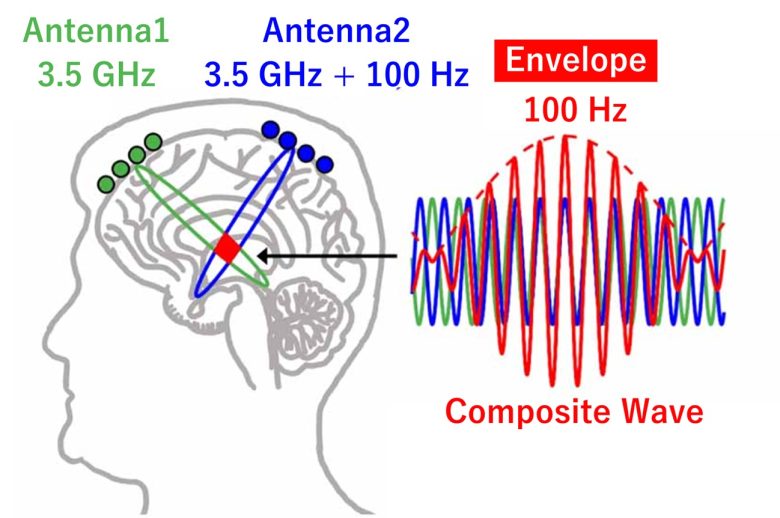
In this study, simulations were performed using 3D models with carrier frequencies of 1.5, 2.5, and 3.5 GHz and a difference frequency of 100 Hz.
The result showed that they can stimulate the center of the brain with an electric field intensity comparable to that of electric current stimulation and with far superior focality.

As the frequency increased, the focus became smaller, whereas electric field intensity decreased.
At a frequency of 3.5 GHz, a focus of 0.47-0.55 in (1.2-1.4 cm) was achieved at an electric field intensity of 0.3 V/m, a sufficient intensity to activate neurons. (*)
At an electric field intensity of 0.2–0.3 V/m, the spikes of neurons in the hippocampus of monkeys were synchronized. (Krause et al. 2019)
In the case of current-based stimulation, even when optimized, the focus is as large as about 4.7 in (12 cm) in diameter at an electric field intensity of 0.3 V/m, so arguably focality has been markedly improved. (Dmochowski et al. 2011)
Several other laboratories are also researching neurostimulation using microwave beams, but so far all of this seems to remain at the simulation stage.
Researchers at the University of Utah have shown that they can wirelessly stimulate the deep brain by focusing multiple microwave beams on specific targets inside the brain. (Lee et al. 2024)

In the simulation, 32 elements of an array antenna were arranged along a hemisphere, and 8 GHz microwave beams were irradiated into the brain.
The results showed that the beams could be focused at any point on the human head.

Iranian researchers have also shown that they can wirelessly stimulate the deep brain by focusing multiple microwave beams on specific targets inside the brain. (Madannejad et al. 2020)
In the simulation, multiple array antennas were placed in a cylindrical shape around the head, and 1 GHz microwave beams were irradiated toward the center of the brain.
The results showed that the electromagnetic force could be focused at a depth of 10 cm (3.9 in) inside the brain.
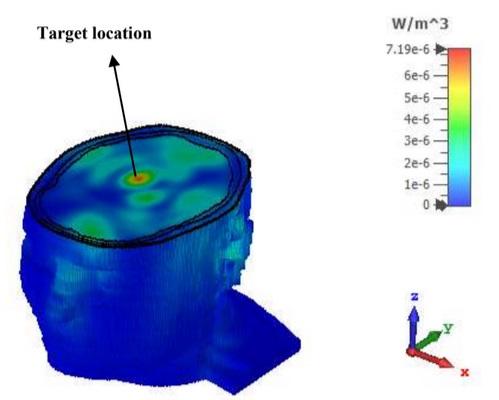
Efforts in the Early Days
The idea itself of activating the brain by focusing microwaves was already around in the 1960s.
In 1968, several researchers claimed that selective stimulation of the deep brain could theoretically be achieved by combining electromagnetic waves with ultrasonic waves. (Schuder and Gold 1974)
In 1969, Dr. Lawrence Pinneo of Stanford Research Institute (now SRI International) proposed several methods for deep brain stimulation using microwaves without implanted electrodes. (Pinneo et al. 1971)
One of these is to stimulate the brain with a composite wave created at the intersection of two microwaves with slightly different frequencies, which is essentially the same as the TI stimulation described above.
The doctor concluded that this would not be feasible because it could not deliver enough energy to activate neurons deep within the brain.
However, this was only a theoretical calculation and wasn't confirmed through actual animal experiments or something.
As we have seen, it has experimentally been proven that even weak electromagnetic waves can affect brain activity through the entrainment principle.
Since some of Dr. Pinneo's other research was conducted under the contract with DARPA (*), this research may have been part of DARPA's Project Pandora, mentioned next.
It was the development of mind-reading technology, and the doctor succeeded in reading seven commands (“right,” “left,” “up,” “down,” “fast,” “slow,” and “stop”) from brainwaves in 1975. (Pinneo et al. 1975)
Mind Control Weapons
So far we have seen that electromagnetic waves can affect brain function, and it appears that the development of mind control weapons has been advancing, applying this technology for military purposes.
Moscow Signal
From 1953 to April 1979, the 10-story U.S. Embassy in Moscow had been attacked with microwaves. (Steneck 1987, Martínez 2019)
This signal came to be known as the Moscow Signal, and it was estimated to have been irradiated at a low intensity of about 0.1-24 µW/cm² in the gigahertz range as a modulated radio-frequency signal for nine hours a day.
Due to its directional and modulated properties, it was obvious that the Moscow Signal was deliberately directed at U.S. personnel.
The incident only came to light in early 1976, and the U.S. government did not inform the general embassy employees until then.
In 1967, a genetic test found chromosomal abnormalities in 20 of 37 exposed individuals, compared with 2 of 7 unexposed individuals. (1.8 times higher chromosomal abnormalities)
In 1968, a screening for the behavioral effects was conducted on embassy employees, but the results were not made public.
In 1976, Time magazine reported that many embassy employees returned to the United States with serious health problems, with two ambassadors dying of cancer and a third suffering from leukemia.
An epidemiological study that began in the same year found a threefold increase in leukemia deaths and a fourfold increase in breast cancer deaths.
The health questionnaires conducted in the same study showed an increase in symptoms consistent with electromagnetic hypersensitivity, including depression, irritability, difficulty in concentration, memory loss, eye problems, psoriasis, skin conditions, anemia, and ulcers.
The U.S. intelligence services claimed that the Soviets had used these waves not to control the minds of diplomats, but to activate listening devices on the walls of the building.
DARPA's Project Pandora
There is a long history of attempts by the Defense Advanced Research Projects Agency (DARPA) to develop techniques for focusing microwave beams to disorient or confuse opponents. (Rose 2006)
In 1965, DARPA had initiated a secret research program called Project Pandora to assess the biological and behavioral effects of low-power microwaves. (Davison 2009)
Mr. Stenneck, a professor of the history of science at the University of Michigan, provides a detailed explanation of this project in his 1987 book, “The Microwave Debate.” (Steneck 1987)
Project Pandora began as part of an investigation into the Moscow Signal.
This program was suspected of being a research program on remote mind control, and the director of DARPA was compelled to account for himself.
In 1976, the director responded to a mailgram addressed to President Ford by assuring the sender that "the Pandora experiments were never directed at the use of microwaves as a surveillance tool nor in a weapon concept."
A year later the director expanded on this point in a written response to a congressional inquiry.
"This agency is not aware of any research projects, classified or unclassified, conducted under the auspices of the Defense Department, now on-going or in the past, which would have probed possibilities of utilizing microwave radiation as a form of what is popularly known as 'mind control.'"
Neither of these statements was historically accurate.
Weaponry and mind control were clearly on the minds of some DARPA officials when Pandora began.
Researchers at the time had already demonstrated that direct electrical stimulation of the brain could alter behavior. (See page 2 onwards of this article.)
The question was whether microwaves could have the same effect even at very low intensities.
This is what Project Pandora initially set out to discover: whether a carefully constructed microwave signal could direct the mind.
Pandora was a multi-million dollar research program with numerous projects.
The main research was conducted at a microwave facility established at the army's Walter Reed Institute of Research.
Here, exposure experiments were conducted using simulated Moscow Signal targeting chimpanzees. Experiments targeting humans were also planned, but it is unclear whether they were actually conducted.
This study did not find any notable biological effects. Other studies also did little to clarify the problem. The results were equivocal in every respect.
And so Project Pandora was canceled in 1969. However, some view the official announcement of the project with skepticism.
Mr. Paul Braude, a science investigative journalist for The New Yorker magazine, suggested that Project Pandora was canceled because of the discovery of serious biological effects that needed to be concealed.
Reportedly, the research program pursued weapons applications and demonstrated the potential of low-power microwaves to interfere with brain function. (Davison 2009)
A document that appears to show the results of experiments conducted at the army's Walter Reed Institute of Research mentions "behavioral performance decrement," "seizures," "gross alterations in brain function," "30 to 100% increases in blood flow," and "lethality." (Bushnell 2001)
U.S. Air Force Non-Lethal Weapons
In 1997, U.S. News reported on the development of non-lethal weapons by the U.S. military, based on interviews with more than 70 experts and a thorough review of documents in the fields of biomedicine and engineering. (U.S. News 1997)
In 2009, Dr. Neil Davison, a senior scientific and policy adviser in the Department of International Law and Policy Arms Unit at the International Committee of the Red Cross, published a book titled “Non-Lethal Weapons,” providing a comprehensive overview of microwave weapons and acoustic weapons developed and possessed by U.S. government agencies. (Davison 2009)
These sources indicate that U.S. government agencies have shown interest in mind control and developed and operated systems to achieve it and that the U.S. Air Force is the main entity behind these efforts.
1982 Air Force Report
In 1982, the U.S. Air Force compiled a report on biotechnology research problems that require solutions for Air Force aeronautical systems planned for development and operation after 2000. (Southwest Research Institute 1982)
The research problems included the biological effects of radio-frequency electromagnetic radiation (RFR), including microwaves.
There is a section titled “RFR Forced Disruptive Phenomena,” and its purpose is stated as to “define the ability of RFR to interrupt, degrade or direct human central nervous system functioning.”
And in its approach, the Air Force virtually acknowledges the ability of electromagnetic waves to exert remote mind control.
"Currently available data allow the projection that specially generated radiofrequency radiation (RFR) fields may pose powerful and revolutionary antipersonnel military threats."
"Experience with electroshock therapy, RFR experiments and the increasing understanding of the brain as an electrically mediated organ suggest the serious probability that impressed electromagnetic fields can be disruptive of purposeful behavior and may be capable of directing and/or interrogating such behavior."
It has also been suggested that electromagnetic waves could be used as a stealth lethal weapon.
"Further, the passage of approximately 100 milliampere through the myocardium can lead to cardiac standstill and death, again pointing to a speed-of-light weapons effect."
"A rapidly scanning RFR system could provide an effective stun or kill capability over a large area."
Furthermore, they speculate that it may be possible to sensitize specific groups to biological weapons by combining electromagnetic waves with biological weapons.
"Using relatively low level RFR, it may be possible to sensitize large military groups to extremely dispersed amounts of biological or chemical agents to which the unirratiated population would be immune."
Air Force Research Laboratory Facilities at Brooks
Research on microwaves for the Air Force was conducted primarily at the Brooks Air Force Research Laboratory in Texas. (Davison 2009, U.S. News 1997)
In order to investigate the safety of radar systems, the laboratory launched a research program on the biological effects of radio frequencies, microwaves, and millimeter waves in 1968.
The program expanded over the years to become one of the world’s centers of expertise.
According to budget documents in 1997, the lab intended to spend more than $110 million over the next six years "to exploit less-than-lethal biological effects of electromagnetic radiation for Air Force security, peacekeeping, and war-fighting operations."
From a paper summarizing this program in 2002, it is clear that this research institute has conducted extremely detailed and wide-ranging investigations into the effects of electromagnetic waves on living organisms.
"At the Air Force Research Laboratory facilities at Brooks, a wide range of RFR exposure parameters are studied, including exposure to microwaves, millimeter waves, high power microwaves (HPM), ultrawideband radiation (UWB), and includes both pulsed and continuous wave, acute, chronic, and repeated exposures."
"The research is conducted at biological levels of organisation from sub-cellular fractions, to cells, rodents, goats, monkeys, and humans. Biological effects studied include the biochemical, genetic, neural, physiological, behavioral, and cognitive."
U.S. Air Force “Controlled Effect”
In 2004, an Air Force science and technology panel identified a concept of "controlled effects" against equipment, communications, and people. (Davison 2009)
Regarding the controlled effects on humans, it states that non-lethal forces can alter individuals' thoughts and manipulate their behaviors, indicating that the U.S. Air Force has a great interest in realizing remote mind control.
"For the Controlled Personnel Effects capability, the S&T [science and technology] panel explored the potential for targeting individuals with nonlethal force, from a militarily useful range, to make selected adversaries think or act according to our needs. Through the application of nonlethal force, it is possible to physically influence or incapacitate personnel. Advanced technologies could enable the warfighter to remotely create physical sensations such as pressure or temperature changes. A current example of this technology is Active Denial … By studying and modeling the human brain and nervous system, the ability to mentally influence or confuse personnel is also possible."
Secrecy Surrounding Electromagnetic Wave Research
From 1980 to 1983, a man named Eldon Byrd ran the Marine Corps Nonlethal Electromagnetic Weapons project. (U.S. News 1997)
"We were looking at electrical activity in the brain and how to influence it."
He conducted experiments on animals and even on himself to see if brainwaves would move into sync with waves impinging on them from the outside.
By using very low-frequency electromagnetic radiation, he found he could induce the brain to release behavior-regulating chemicals.
"We could put animals into a stupor."
He even ran a small project that used magnetic fields to cause certain brain cells in rats to release histamine.
In humans, this would cause instant flulike symptoms and produce nausea.
"These fields were extremely weak. They were undetectable." "The effects were non-lethal and reversible. You could disable a person temporarily."
Mr. Byrd says he was told his work would be unclassified "unless it works."
Because it worked, he suspected that the program "went black."
Other scientists told similar tales of research on electromagnetic radiation turning top secret once successful results were achieved.
Concerned Scholars
Ethicists have issued stern warnings regarding the development of this new weapon, which is being carried out in extreme secrecy. (U.S. News 1997)
There are treaties and conventions governing the use of bullets and bombs in war, but there are currently no treaties regulating the use of non-lethal weapons.
And no one knows what will happen to people exposed to them over the long term.
Medical researchers were concerned that research into electromagnetic waves for therapeutic purposes could be used for weapon development.
In fact, the military routinely approached the National Institutes of Health for research information.
"DARPA has come to us every few years to see if there are ways to incapacitate the central nervous system remotely," said the head of the Neural Prosthesis Program at NIH.
The U.S. Air Force expects to have microwave weapons by the year 2015 and other non-lethal weaponry sooner.
"When that does happen," warned a professor of national security affairs at the U.S. Army War College, "I think there will be a public uproar. We need an open debate on them now."
In 1993, during the Battle of Mogadishu in Somalia, the use of lasers as an auxiliary weapon against personnel was confirmed. The International Red Cross and Human Rights Watch have since led a fight against antipersonnel lasers.
Dr. Davison of the International Red Cross has indicated that research into weapons that interfere with brain function is being carried out under the banner of developing non-lethal weapons. (Davison 2009)
And he has warned that conspiracy theories about the government using microwaves for remote mind control are becoming a reality.
Recent Cases of Microwave Attacks
Havana Syndrome
In late 2016, U.S. Embassy personnel in Havana, Cuba, began to report unusual symptoms and signs with unknown causes. (National Academies of Sciences, Engineering, and Medicine 2020)
At the request of the Department of State, the National Academy of Sciences formed a committee to investigate the matter.
The most characteristic symptoms and signs were the sudden onset of a perceived loud sound, a sensation of intense pressure or vibration in the head, and pain in the ear or more diffusely in the head.
Most individuals reported that the sound or these other sensations seemed to originate from a particular direction and were perceived only when the individual was in a specific physical location.
Some also reported sudden onset of tinnitus, hearing loss, dizziness, unsteady gait, and visual disturbances.
Other personnel attached to the U.S. Consulate in Guangzhou, China, reported similar symptoms and signs to varying degrees, beginning in the following year.
The committee found the series of symptoms and signs to be consistent with the effects of directed energy with pulse-modulated radio frequencies.
Attack from China's Military to India's
In November 2020, the Times reported that China’s military used microwave weapons to force Indian troops to retreat during a months-long border standoff in the Himalayas. (The Times 2020)
According to a professor of international relations at Beijing-based Renmin University, its forces had turned two strategic hilltops that had been occupied by Indian soldiers "into a microwave oven," forcing them to retreat and allowing the positions to be retaken without an exchange of conventional fire.
The professor said that Chinese troops fired the weapon from the bottom of the hills and “turned the mountain tops into a microwave oven.”
“In 15 minutes, those occupying the hilltops all began to vomit,” he further continued. “They couldn’t stand up, so they fled. This was how we retook the ground.”
The U.S. deployed its own vehicle-mounted microwave weapon, called an Active Denial System, to Afghanistan ten years ago, but it was withdrawn, reportedly without being used in combat.
This incident may be the first use of microwave weapons against enemy forces.
Ultrasonic Waves
Ultrasonic waves are acoustic waves at frequencies above 20 KHz, which is inaudible to the human ear, and can be steered and focused in the brain on a millimeter scale. (Naor et al. 2016)
The activation of the nervous system by ultrasonic waves was already observed experimentally in the 1920s.
Since the 2000s, research into neuromodulation using ultrasonic waves has been actively conducted.
Arizona State University researchers showed that neurons can be activated with ultrasonic waves of low intensity that do not cause tissue damage. (Tyler et al. 2008)
Irradiating hippocampal slices from mice with low-intensity ultrasonic waves of 23 mW/cm2 pulsed at 10 Hz caused the neurons to fire.
When these ultrasonic waves were applied to the motor cortex of the brains of rats, they were able to move rats' bodies. (Tufail et al. 2010)
The ultrasonic waves activated several muscle groups almost simultaneously, causing the tail, forelimb, and whiskers to twitch at the same time.
Shifting the stimulation site by a few millimeters induced activity in different muscle groups, but limited activation of specific body parts could not be achieved.
Researchers at Harvard University successfully activated specific sites of the brain using the technology of focusing ultrasonic waves. (Yoo et al. 2011)
Irradiating the motor cortex of rabbits with 690 kHz focused ultrasonic waves pulse-modulated at 10 Hz enabled a movement of only the forelimb of the rabbits.

Examination of the brain activity in the rabbits revealed selective activation of the target region in the motor cortex.

Researchers at the University of Washington developed a technology that activates neurons using a composite wave formed at the intersection of two ultrasonic waves with different frequencies. (Mehić et al. 2014)
In the experiment, two ultrasonic waves of 1.75 MHz and 2.25 MHz were superimposed to generate a 2 MHz composite wave with an envelope of 500 kHz.
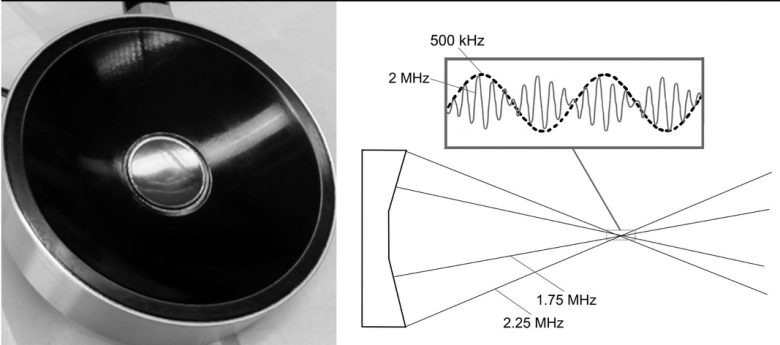
When the focused ultrasonic waves were applied to the parietal lobe of the mice, which is where the motor cortex is located, motor responses were induced in the forelimb, hindlimb, and whiskers, depending on the site irradiated.
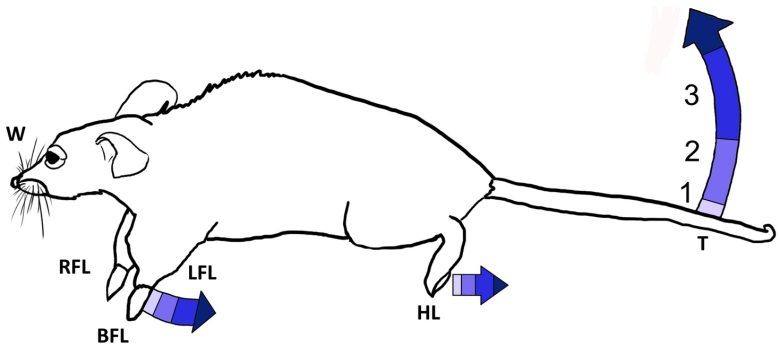
This is the same method as TI stimulation, in that it activates neurons with a composite wave created at the intersection of two waves with different frequencies.
Ultrasonic waves have been confirmed to be able to modulate activity deep within the large brains of primates.
British researchers targeted the amygdala and anterior cingulate cortex, located deep within the brain, of rhesus monkeys and irradiated them with 250 kHz ultrasonic waves pulse-modulated at 1 Hz for 40 seconds. (Folloni et al. 2019)

The functional connectivity of the target region with other brain regions was reduced for several tens of minutes after irradiation, meaning that ultrasonic waves disrupted normal brain activity in the target regions.
Direct Electrical Stimulation of the Brain
Electrical brain stimulation has a long history, dating back to the early 19th century. (Sironi 2011)
The first recorded case was in 1804, when an Italian physicist applied electrical stimulation to the cerebral cortex of a decapitated prisoner, inducing a grimace.
Several sporadic experiments on electrical brain stimulation were conducted thereafter, but no significant progress was made until the 20th century.
In the 1930s, American-Canadian neurosurgeon Dr. Wilder Penfield performed functional mapping of the sensory and motor cortices of humans using electrical stimulation, creating the world's first cortical homunculus.
Also in the 1930s, Swiss physiologist Dr. Walter Hess began functional mapping of the diencephalon in cats and discovered that emotions such as rage and fear could be induced by electrical stimulation of the deep brain.
Entering the 1950s, research into electrical brain stimulation became increasingly active.
These studies have revealed that stimulating specific sites of the brain can induce an extremely wide variety of emotional and behavioral changes, depending on the sites stimulated.
This certainly shows the potential for mind control if abused.
The following pages will delve into experiments involving direct electrical stimulation of the brain using humans and animals, with a particular focus on experiments targeting the deep brain, which show dramatic effects.

